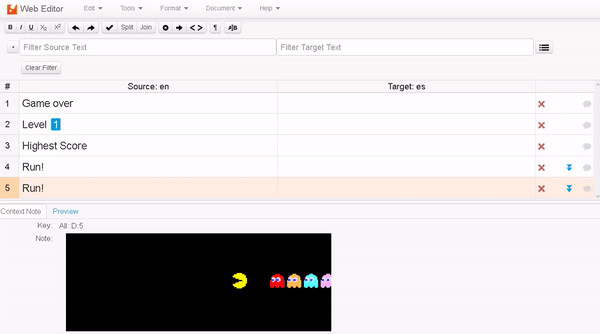
Blog
Machine Translation Report
What is the optimal MT Engine for you? Find out in the latest MT Report by Memsource.

Curious about continuous localization? In part two of our continuous delivery triad, we tackle some of the most common questions: is continuous localization a myth or reality; does continuous delivery really pay off; can it be successfully implemented into a game localization workflow; and beyond.
Have you read part one of our series on the difference between the three major workflow strategies?
There are many benefits to continuous delivery (CD) especially in game localization but new technologies and strategies are often met with reluctance. Andrea Tabacchi, lead of the Memsource Solution Architect team, has been closely following the trend of continuous delivery. We asked him about the main concerns people have about adopting CD, the benefits and drawbacks of implementing it into a game localization strategy, and some best practices for game localization managers looking to put continuous localization into action.
How can the gaming industry benefit from implementing continuous delivery methods?
Gaming is a unique industry – it’s highly technological but the content is also incredibly creative. In some cases, the narrative is so important that you cannot really start your localization work until the story, characters, and dialogues are well defined. It would be similar to translating a book while the author is still writing it.
But not all games are like that. Casual games — games aimed at mass audiences with simple rules and low time commitment — are definitely a good candidate to implement CD. New levels or features can be sim-shipped daily if stakeholders are working in a well-oiled mechanism, allowing millions of users to have the same gaming experience all over the world.
Are there any drawbacks or concerns using this method?
Two of the biggest hurdles to overcome are scope uncertainty and translating in context.
Scope Uncertainty
The amount of content can change daily with two major drawbacks – on the customer side you can easily lose control of the budget and on the language service provider (LSP) side you may have a hard time allocating resources (and paying them fairly for their job and their availability). The role of the localization manager is to set a monthly approximate volume, set some checkpoints, and define the corrective measures before the situation gets worse. If this isn’t taken into account, you can find yourself running out of money or resources in the middle of the localization effort.
Translating in Context
In game localization, context is crucial. Translating two strings here and there without context can be a difficult task, especially in maintaining game storylines. It’s important that contextual information is always provided for the most important strings, such as adding meta information according to the visibility of the content.
One of the key aspects in continuous delivery is to anticipate issues before testing. Applying it to localization, this would mean: spending time on internationalization, providing context information, reducing bottlenecks in communication, anticipating LQA by doing pseudo-translation or MT to identify cosmetic issues upfront and make sure that whatever happens in LQA is then propagated in the translation environment.
What advice can you give to localization managers who want to adopt continuous delivery into their game localization strategy?
Making the shift to CD can be tricky and will require a lot of planning and preparation. The transition may not be perfect, and there will most likely be some bumps in the road, but here are a few tips to help pre-empt the possible bumps for a smoother changeover:
- Get Ready: Prepare your team so that they welcome the change and not avoid it. The more you refuse the inevitability of change the harder it will bite when it comes.
- Partner-up: Find the right partners in a technology platform and vendors that can really understand your needs and involve them in the team as early as possible.
- Analyze Your Workflow: Look at your localization process as a flow of content and remove as many obstacles as you can before deploying it into production. If there are lots of difficulties, perhaps try a piecemeal approach. Find a workflow step where there is no obstacle, however small, and start there. The evolution of technology is organic – just starting is the most important thing because it changes everyone’s mindset. But don’t force it, the good old agile is still working fine and may be the solution for you.
- Integrate and Automate: Once you have eliminated all the friction in the process, make sure that the content and the queries are flowing to the relevant stakeholders without difficulty and that everybody knows what to do when something is landing on their desk. For example, Memsource allows the connection between the localization interface and query management solution like Jira via API allowing users to communicate and work in the respective environment.
- Context is Key: Translating without context, especially creative content, is like putting together a pictureless puzzle. Sure it can be done, but it will take a lot longer and there will be many more mistakes. Give context and you will reduce errors, delays, and queries! Did you know that Memsource supports GIF as context information? You can see the game in action while localizing the string.

- Keep Trying: Don’t give up after the first try – learn from your mistakes, iterate, and keep looking for new ways to improve your workflow.
Final Thoughts
It is essential to assess your game localization process and see whether CD will provide concrete benefits before fully committing. Maybe you are satisfied with weekly drops, or you fear that constant changes will end up doubling your costs; always be sure that the advantages outweigh the disadvantages. CD has its place in some game localization workflows, but not all.
Once you have committed, remember to be well prepared, find yourself a good team, integrate and automate, and if at first you don’t succeed, dust yourself off and iterate.
In the final part of this three-part series, Andrea asses the possible disruptors of continuous delivery and how to minimize the potential debris. Keep reading.
About the Author
 Andrea Tabacchi is the Solution Architect Team Lead at Memsource where he utilizes his extensive experience in building customer-centric language technology solutions for multinational corporations and global translation companies. He and his team work with clients to develop solutions to address their translation technology needs, including innovative ways to optimize the Memsource platform and liaise with clients and internal teams to suggest tool improvements. Prior to Memsource, Andrea spent seven years on the LSP side where he served in several roles in language technology, from Localization Engineering to Technology Director.
Andrea Tabacchi is the Solution Architect Team Lead at Memsource where he utilizes his extensive experience in building customer-centric language technology solutions for multinational corporations and global translation companies. He and his team work with clients to develop solutions to address their translation technology needs, including innovative ways to optimize the Memsource platform and liaise with clients and internal teams to suggest tool improvements. Prior to Memsource, Andrea spent seven years on the LSP side where he served in several roles in language technology, from Localization Engineering to Technology Director.
.jpg)


